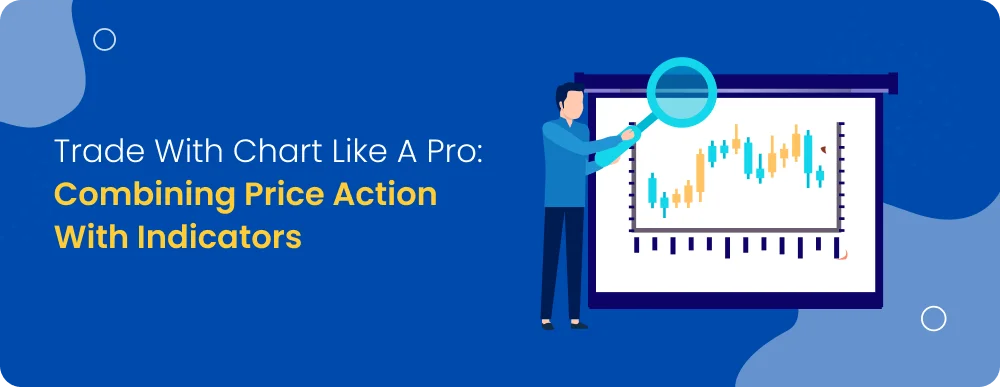Trade With Chart Like A Pro: Combining Price Action With Indicators
Noor Kaur
16 Sept 2025Tags:
Featured
Key Takeaways
Price action trading gives the raw market view, while indicators provide confirmation.
Keep charts clean and use only one or two of the best indicators with price action setups.
Confluence matters, so wait for price action and indicators to align before entering trades.
Check multiple timeframes to avoid false signals and improve accuracy.
Discipline beats complexity: a simple price action and indicator strategy often outperforms cluttered charts.
Trade with Chart Like a Pro: Combining Price Action with Indicators
Successful traders don’t just react to random signals—they read the chart like a story. Price action trading gives you the raw view of how buyers and sellers are moving the market, while carefully chosen stock indicators add an extra layer of confirmation.
By combining the two, you create a balanced approach that captures trends early, avoids noise, and improves decision-making. Read along to know more!
Understanding Price Action: Reading the Raw Chart
Price action is the foundation of technical analysis. It refers to studying the raw movement of price on a chart—without relying heavily on stock indicators. Traders look at candlestick patterns, support and resistance levels, breakouts, and trendlines to understand how buyers and sellers are behaving in real time.
By reading a price action chart, you can spot shifts in momentum, identify trading price action trends, and build entry/exit strategies without overcomplicating the process. Many successful price action trading strategies keep the chart clean by using only a few important tools for confirmation.
Suggested Read: How to Develop Your First Algo Trading Strategy
Types of Technical Indicators and Their Purpose
While price action tells the story of the market, technical indicators provide confirmation and deeper insights. Indicators fall into different categories based on their function:
Trend Indicators: Show the overall market direction and help confirm breakouts or reversals.
Momentum Indicators: Highlight whether a stock is overbought or oversold.
Volatility Indicators: Measure price fluctuations and help set stop-loss levels.
Volume Indicators: Show how strong or weak a move is by tracking trading activity.
Best Indicators to Pair with Price Action
While price action trading provides the raw view of market trends, combining it with the right trading indicators increases accuracy. Here are some of the best options:
Moving Averages (SMA/EMA): Help confirm trend direction when paired with support/resistance zones on a price action chart.
Relative Strength Index (RSI): A strong price action indicator for spotting overbought/oversold zones and validating breakouts.
MACD (Moving Average Convergence Divergence): Works well to confirm momentum shifts after a candlestick pattern or trendline breakout.
Volume Indicators (OBV, VWAP): Add conviction to price action strategies, ensuring that a move is backed by real trading activity.
Bollinger Bands: Useful for pairing with candlestick rejections at extremes to gauge volatility.
Step-by-Step Strategy: Combining Price Action with Indicators
Here’s a simple process you can follow to merge price action with indicators effectively:
Read the Price Action First: Start with a clean price action chart. Identify key levels: support, resistance, trendlines, and candlestick patterns.
Add One or Two Confirming Indicators: Choose a trend indicator (e.g., EMA) to confirm direction. Add a momentum indicator (e.g., RSI) to check strength or exhaustion.
Wait for Confluence: Look for moments when price action (like a breakout or rejection) aligns with your indicator signals. For example, a bullish candlestick breakout at resistance and an RSI moving above 50 is a very strong signal.
Plan Entry and Exit: Enter when both price action and your stock indicators align, and set stop-loss just below support or recent swing low. Use indicators like ATR or VWAP to fine-tune stop-loss and targets.
Review and Adjust: Track how your price action strategies perform. Adjust the indicator settings (like period for RSI or EMA) based on the timeframe you trade.
Common Mistakes to Avoid When Combining Both
Even though combining price action with indicators can improve accuracy, many traders misuse them and end up hurting their performance. Here are the most common pitfalls to avoid:
Overloading the Chart with Too Many Indicators: Adding multiple stock indicators creates conflicting signals. Stick to the best combination of indicators—usually one trend tool (like EMA) and one momentum tool (like RSI)—with a clean price action chart.
Letting Indicators Lead Instead of Price Action: Indicators should confirm, not dictate. A price action strategy should always start with support/resistance, candlesticks, and market structure, with indicators used only for confirmation.
Ignoring Timeframes: A setup that looks good on a 5-minute chart may not align with the daily trend. Failing to check multiple timeframes leads to false confidence in weak setups.
Chasing Every Signal: Traders often jump into trades just because an indicator flashes “buy” or “sell.” Without waiting for price action confirmation, this results in false signals and losses.
Not Testing Your Strategy: Using price action indicator trading without backtesting is risky. What looks like the best price action indicator on TradingView might not perform well across different stocks or timeframes.
Suggested Read: 5 Must-Know TradingView Features For Beginners
Conclusion
Mastering the use of price action with indicators is less about stacking tools and more about maintaining clarity and consistency. A simple setup, such as candlestick analysis with a moving average or RSI, can often outperform a cluttered chart filled with conflicting signals. The key is to let price action strategies lead and use trading indicators only as confirmation through advanced trading app.
FAQs
Why should I combine price action with indicators?
Combining price action with indicators allows you to confirm what you see on the chart. While price action trading shows raw market movement through candlesticks and support/resistance zones, trading indicators like RSI or moving averages add extra confirmation. This helps filter noise and improve accuracy when trading price action trends.
How many indicators should I use in a single strategy?
The best approach is to keep your chart clean. Instead of cluttering it with too many stock indicators, stick to the best combination of indicators—usually one momentum indicator (like RSI) and one trend indicator (like EMA). Pairing them with a price action chart is often enough to build effective price action strategies.
Do I need a premium charting platform for this strategy?
You don’t need a premium tool to start, but platforms like TradingView make analysis smoother. They offer the best price action indicators, customizable alerts, and clean visuals that make it easier to combine candlestick patterns with technical signals.
What timeframe works best for combining price action and indicators?
The ideal timeframe depends on your trading style. Price action strategies on shorter timeframes (5–15 minutes) are good for intraday traders, while swing traders prefer higher timeframes like daily or weekly charts. Always align your price action with indicators on multiple timeframes to avoid noise.
What’s the biggest mistake traders make when combining both methods?
The most common mistake is over-relying on too many trading indicators instead of focusing on clear price action trends. A chart filled with tools can create confusion, while a simple price action indicator trading works better when combined with just one or two supporting signals.
How do I avoid false signals when using indicators?
To reduce false signals, always let price action lead and use indicators only as confirmation. For example, if a breakout appears on the price action chart, wait for a signal from your chosen indicator (like MACD or RSI). This combination ensures stronger entries and avoids chasing unreliable setups.
Noor Kaur
16 Sept 2025Related blogs


Intraday Trading Strategy: Open High Open Low Approach
Intraday trading is one of the most exciting and rewarding types of online stock trading. As a day trader, you sho...


Understanding NISM Certification : Everything You Need to Know | mastertrust
In today's world, more and more people are getting curious about finance and the world of money. It doesn't matter...


Seeking Better Returns Than FDs? Explore These Options | mastertrust
Fixed deposits are a popular investment choice because of their guaranteed returns and safety.


Role of Inflation in Long-Term Investment Planning
In Financial Planning, one of the things that plays a key role is the impact of inflation on your investments.
Sign up to our newsletter !
Share this article on
Recent articles
Tags:
Open a Demat Account in just 15 minutes !

Click on open
account below

Fill out some
basic details

Upload your
documents

Start trading in
24 Hours *
Commonly asked questions
Is Master Capital Services Limited SEBI registered?
Do you have a mobile app for Trading and Finance Management?
What services does mastertrust provide?
What is the minimum investment required to start trading with your company?
Is my personal and financial information secure with your company?
What is your customer support availability?





